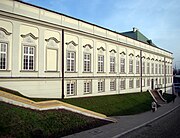| Copper-Roof Palace | |
|---|---|
| Pałac Pod Blachą | |
 Copper-Roof Palace Copper-Roof Palace | |
| General information | |
| Architectural style | Rococo |
| Town or city | Warsaw |
| Country | Poland |
| Construction started | 1698 |
| Completed | 1701 |
| Demolished | 1944 |
| Client | Jerzy Dominik Lubomirski |
| Design and construction | |
| Architect(s) | Jakub Fontana |
| UNESCO World Heritage Site | |
| Type | Cultural |
| Criteria | ii, vi |
| Designated | 1980 |
| Part of | Historic Centre of Warsaw |
| Reference no. | 30bis |
| Historic Monument of Poland | |
| Designated | 1994-09-08 |
| Part of | Warsaw – historic city center with the Royal Route and Wilanów |
| Reference no. | M.P. 1994 nr 50 poz. 423 |
The Copper-Roof Palace (Polish: Pałac Pod Blachą) is an 18th-century palace in Warsaw, Poland. It takes its name (which is less precisely phrased in the original Polish) from the copper roof, a rarity in the first half of the 18th century. Since 1989 the palace has been a branch of the Royal Castle Museum.
The palace is contiguous with Warsaw's Royal Castle, and down a slope from Castle Square and Warsaw's Old Town. Beneath the palace, a 17th-century lodge still exists.
History
The original patrician house of Wawrzyniec Reffus was built in 1651–1656. After its 1657 destruction by the army of George II Rákóczi, it was completely remodeled in 1698–1701 for Jerzy Dominik Lubomirski.
Lubomirski built on a southern wing, perpendicular to the rest of the structure, and expanded the western elevation. Soon after, the palace came to be called Palais Martin after Lubomirski's grandson. In 1720 the palace was rebuilt with the addition of a second, northern wing; and the interior was decorated with rococo paintings.
After 1777 the palace passed into the possession of Poland's last king, Stanisław August Poniatowski (regnal name Stanislaus II Augustus), who hired the architect Domenico Merlini to redesign the rooms and to join the Royal Castle's library wing to it.
The King then presented the redecorated palace to his nephew, Prince Józef Poniatowski. The Prince was a successful commander in the 1794 Kościuszko Uprising, and later one of Napoleon Bonaparte's marshals. Under the Prince's ownership, the palace became a center of Warsaw's high-class social scene.
When Warsaw became part of the Kingdom of Prussia after the Third Partition of Poland (1795), the palace became a Prussian Ministry of War headquarters.
The left wing and the corps de logis (central building) of the Copper-Roof Palace were deliberately burned in 1944 by the occupying German forces during the Second World War. The right wing survived. In 1948–1949 it was reconstructed, based on 18th-century paintings by Bernardo Bellotto.
The palace is now a museum, part of Warsaw's Royal Castle, and hosts a historic library and a permanent exhibit of oriental rugs.
Gallery
-
 Aerial view
Aerial view
-
Front view
-
 Southern (right) façade
Southern (right) façade
-
 Eastern façade, St. Anne's Church on the left, Royal Castle on the right
Eastern façade, St. Anne's Church on the left, Royal Castle on the right
-
Exhibition of oriental rugs
-
Prince Józef Poniatowski's bedroom
See also
References
- In-line:
- Zarządzenie Prezydenta Rzeczypospolitej Polskiej z dnia 8 września 1994 r. w sprawie uznania za pomnik historii., M.P., 1994, vol. 50, No. 423
- "Remont i przebudowa pałacu Pod Blachą". www.zamek-krolewski.pl (in Polish). Archived from the original on 2010-09-29. Retrieved 2009-03-23.
- ^ "The "Pod Blachą" Palace". eGuide / Treasures of Warsaw on-line. Archived from the original on 2006-02-18. Retrieved 2009-03-23.
- ^ "Pałac pod Blachą". www.warszawa1939.pl (in Polish). Retrieved 2009-03-23.
- ^ ""Under the Metal Roof" Palace (Palac Pod Blacha)". www.wiezowce.waw.pl. Archived from the original on 2014-02-04. Retrieved 2009-03-24.
External links
52°14′51″N 21°0′57″E / 52.24750°N 21.01583°E / 52.24750; 21.01583
Categories: